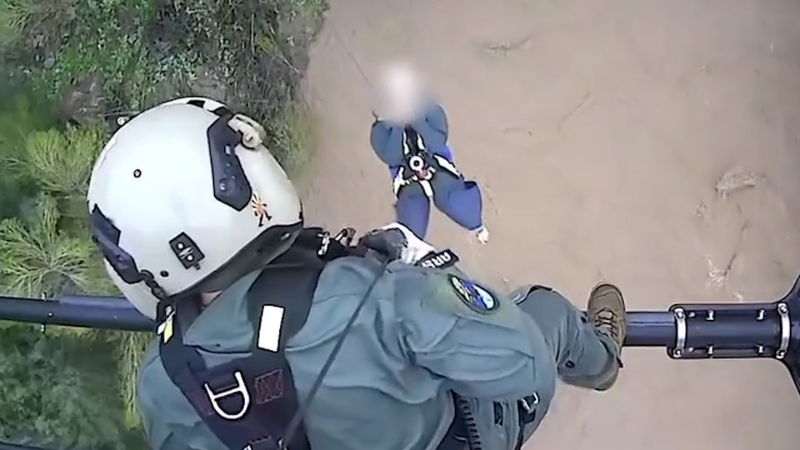Biggest storm of winter to bury part of Sierra Nevada with over 100 inches of snow
A blizzard lasting days will blast the Sierra Nevada and Siskiyous with tremendous snow this weekend with the likelihood of travel shutdowns and life-threatening conditions.
Storm Chaser Brandon Clement joins Bernie Rayno and Kristina Shalhoup to discuss the hazardous conditions in California.
A massive storm will unload a general 6-10 feet of snow and bring high winds in the Sierra Nevada through this weekend. The storm will not only close the major roads in the passes but may bury and isolate communities for an extended period, AccuWeather meteorologists warn.
"The snow will fall at the rate of 4 inches per hour at times, while 60- to 75-mph winds will create a dangerous blizzard with mountainous snowdrifts," AccuWeather Chief On-Air Meteorologist Bernie Rayno. The AccuWeather Local StormMax™ gust for the ridges and peaks of the Sierra Nevada is 90 mph.

The storm will create potentially deadly travel conditions along two major arteries in California.
"Donner Pass, California, along Interstate 80 and segments of I-5 in Northern California to Siskiyou Summit in southern Oregon are likely to close," Rayno added.
There is a high risk of motorists becoming stranded due to the incredible snowfall rates and the likelihood that road crews will be unable to keep up with the storm until it concludes late this weekend. This includes roads to and from the ski resorts in the region. Conditions may be life-threatening for those who become stuck outdoors in the storm.
The combination of heavy snow and high winds is likely to lead to power outages that could take many days, if not weeks, to resolve in isolated areas. Those in backwood locations will need a safe means of heat and plenty of food. Experts warn that chimneys and exhaust from furnaces will need to be kept open to avoid carbon monoxide poisoning.

Compared to past snowfall data and what is expected to fall, this storm has the potential to rank with some of the biggest that the Sierra Nevada has ever seen in modern times and could eclipse the big storm from late February 2023, AccuWeather Meteorologist Alex DaSilva said.
For example, at Donner Pass, California, one storm of note spanned eight days and dropped a whopping 154 inches of snow in January 1952, according to the Truckee-Donner Historical Society. The mid-20th century storm's combination of 80-mph winds and snow produced drifts to 40 feet.
AccuWeather is projecting that 6-10 feet of snow will fall at Donner Pass or up to 120 inches, spanning several days. Similar snowfall is likely at many of the ski resorts in the Sierra Nevada, with an AccuWeather Local StormMax™ snowfall of 15 feet or 180 inches. Drifts from the storm will reach as high as several stories.

Last winter's megastorm that spanned the last few days of February and into March brought 55-60 inches of snow to South Lake Tahoe Airport, California. The storm this weekend is projected to be on par with that intensity.
Much of the storm's moisture will leave Southern California before the air turns cold enough for snow to fall. At the tail end from late Saturday to early Sunday, there may be enough of a combination of cold air and moisture to bring some snow to the ridges and peaks in Southern California, but little to no accumulation is anticipated over the passes, including the Grapevine.
AccuWeather's California Expert Ken Clark believes that this single storm may wipe out the current Sierra snowfall deficit this season.

Even with the deficit before the start of the storm, the combination of excessive snowfall from last winter and ongoing rain and snow this winter has most reservoirs near full capacity and streams running high.
The snowpack that builds into the early spring over the Sierra Nevada is the lifeline for much of California's water supply through the year. The gradually melting snow later in the spring and summer keeps the streams flowing and tops off lakes and reservoirs.

With the center of attention deservingly on the magnitude of mountain snow from the storm, there will be rain to deal with at the lower elevations.
"This storm will have enough breaks in the rain at lower elevations to avoid major and long-lasting flooding problems," AccuWeather Senior Meteorologist Heather Zehr said. There will be enough rain to slow travel and lead to minor incidents of flash flooding in the northern part of the state through this weekend and trigger sporadic travel delays in the southern part of the state during the weekend.

Zehr pointed out that persistent strong winds from the northwest will lead to pounding waves, coastal flooding and perhaps erosion along the California coast, especially in the stretch from near San Francisco on south to Point Conception.
While winds cause trouble along the California coast and lead to a blizzard in the Sierra Nevada and Siskyous, 40- to 60-mph gusts will kick up dust, raise the wildfire danger and may lead to high-profile vehicle roll-overs over interior Southern California and the interior Southwest states in general.

Over the interior Southwest, an AccuWeather Local StormMax™ wind gust of 90 mph is projected.
Want next-level safety, ad-free? Unlock advanced, hyperlocal severe weather alerts when you subscribe to Premium+ on the AccuWeather app. AccuWeather Alerts™ are prompted by our expert meteorologists who monitor and analyze dangerous weather risks 24/7 to keep you and your family safer.
Report a Typo














